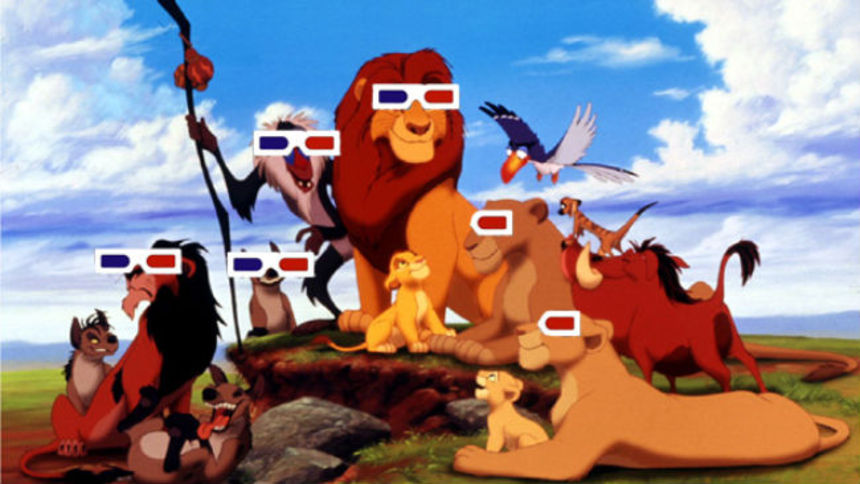Hollywood Grind: How Post-Conversion 3D Changes Movies

Originally released in 1994, The Lion King won critical success, enjoyed huge returns at the box office, introduced Elton John (who co-wrote several songs) to a new audience, and inspired a hit Broadway musical. Disney will be releasing the film on 3D Blu-ray on October 4, and in advance of that will open it in U.S. theaters for a two-week engagement on September 16.
The Lion King is a very good film, beloved by many, including myself, so I was eager to see it again in a theater. At an advance screening filled with children and their parents, however, I found myself distracted by noticeable changes to the film that were made by the 3D presentation.
Back in January, when Disney announced their plans, they made clear their intention to offer "movie-lovers the most incredible in-home entertainment experience they will ever have." (Emphasis added.) Stereographer Robert Neuman, in charge of the conversion, explained the process, saying in part: "If there's a scene where we're supposed to feel detached from a character, then I put the character further back into the background. If we're supposed to feel connected to a character, I bring them further forward. In this way, we're not using 3D randomly. We're using 3D as part of the narrative."
Neuman says that the theatrical presentation is "basically the same version" as the one designed for home viewing. Here's an example of what distracted me:
As "The Circle of Life" plays during the opening sequence, flocks of animals gather to celebrate the birth of Simba, the heir to the crown of the Lion King, Mufasa (voiced by James Earl Jones). As the scene moves toward its climax, Zazu the bird flies toward Mufasa, who is striding out on Pride Rock, high above his kingdom. The intent of the scene is clear: Birth leads inevitably to death, yet is continually renewed; all animals are important and have a role to play in the kingdom; the kingdom needs a good, wise, and visible leader. Therefore, King Mufasa is the most important one in the kingdom, but he is a kind and benevolent king, and so the animals are glad to show obeisance toward their current ruler and rejoice in the birth of their future King.
But because Neuman decided that Zazu is more important in that moment than Mufasa, Zazu is brought forward and Mufasa is pushed into the background for the duration of Zazu's flight. Thus, we are dazzled by Zazu's flight high above the other animals -- it's a magical thing to watch a winged creature soaring on currents of air -- and when the focus finally changes to a lion standing on top of a rock, we wonder how he will be helping Zazu.
As a result, the meaning of the scene is affected. The emphasis is placed on Zazu, a secondary character, rather than Mufasa, a lead character. The entire movie revolves around the responsibility of rulership, and the challenge that Simba faces in living up to the magnificent example set by his father. When Mufasa struts out proudly, it tells us something about his character, establishing both his pride in being a new father and his pride in his kingdom and his subjects. Cutting that short for the sake of the 3D process weakens the sequence.
It's a small thing, but scenes are composed of many such small things. Removing, or changing the emphasis, of even one element can make a profound difference. (Who shot first, Han or Guido?) Other scenes are changed as well: Leaping antelopes that were formerly part of the background suddenly spring into the foreground; Timon, Pumbaa, and Simba are brought so far to the foreground during "Hakuna Matata" that it looks like they're refugees from a 1950s studio-bound Technicolor adventure, complete with rear-projected jungle wildlife behind them.
Neuman is not the villain here. He is quoted as saying: "The input we were able to get from the original directors, Roger Allers and Rob Minkoff, and the producer, Don Hahn, was extremely reassuring. It was great to make sure that what we were implementing was their vision." Neuman did the job he was hired to do. The movie is not ruined, but the meaning and/or impact of certain scenes are altered or diluted.
"Even if you've seen the movie a hundred times," Neuman says, "you'll feel like you're seeing it for the first time when you see it in 3D." Indeed.
The Lion King will be available in various formats, including DVD, Blu-ray, and 3D Blu-ray, and in various packages on October 4.
Picture credit: Techland.Time.com.







